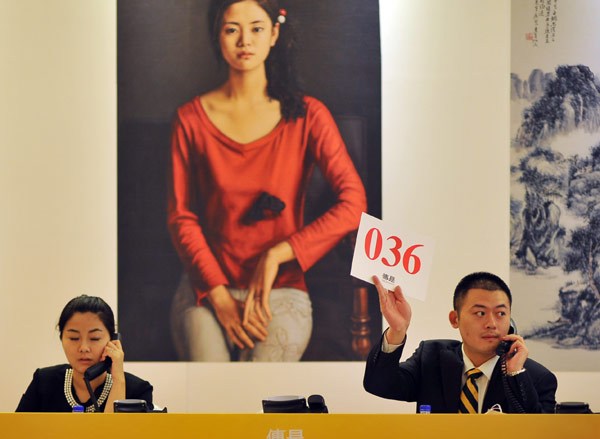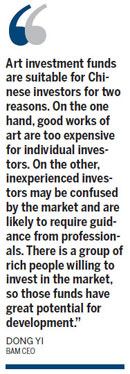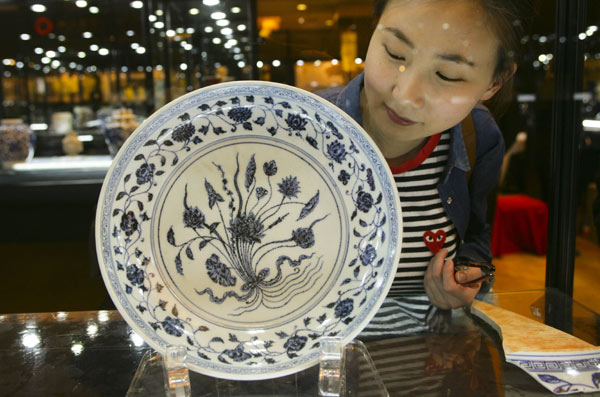Buyers in the frame to hedge against risks in other sectors, report Zhu Jin, Pei Pei and Jiang Xueqing in Beijing.
 |
|
A woman takes a phone bid at Beijing Tranthy's 2012 Spring Auction on May 16. Hu Yilin / for China Daily |
Based on his previous investment experience, Zhao, who runs an international trading business in Beijing, believed art could become a highly profitable tool to hedge against inflation.
Make no mistake, art is big business. Earlier this month The Scream, probably the most famous work by the Norwegian artist Edvard Munch, sold for $119.9 million in New York. That price tag saw the painting become the most expensive work ever sold at auction, despite being one of four copies made by the artist. The other three are all owned by museums in the artist's home country.
After consulting friends and several contacts at BAM, Zhao began to invest in art at the end of 2010. He now puts around 20 or 30 percent of his total annual investment into art funds, equivalent to 2 to 3 million yuan ($317,420 - $475,970).
|
|
When traditional investments, such as equities and real estate, were in recession in 2011, art funds prospered as investors sought a hedge against long-term inflation. More than 70 funds have been founded by nearly 30 art investment companies since 2009 with a combined value of 5.77 billion yuan, according to an investigation by the Chinese magazine, Money Journal, at the end of 2011.
"Although the total scale of art investment is still small compared with other funds, it has taken less than five years to realize such a dramatic increase," said Feng Pengcheng, a professor of economics at Beijing's University of International Business and Economics.
Although art investment funds are a relatively new phenomenon in China, they've been used extensively and profitably in other countries. For example, the British Rail Pension Fund was founded in the 1960s when the UK was facing severe currency devaluation. Having consulted senior managers at the auctioneer Christie's, the fund's trustees realized that buying works of art was an effective way of combating inflation and also that the artworks were likely to rise in value, especially once economic stability had been restored.
Rising art investment
However, compared with art funds overseas, those in China have shorter investment periods and also differ in the expected yields and profit distribution, among other aspects.
Data from the National Bureau of Statistics show that China's consumer price index hit 3.3 percent in 2010, rising from minus 0.7 percent in 2009. The country's art investment market rose in tandem with that inflation, especially in terms of auction prices.
According to Art Market Trends, 2010, a report published by Artprice, a renowned data provider, China overtook the United States as the leader in fine art auction sales in 2010, with total revenue of $3 billion, accounting for 33 percent of the global turnover for fine art auction sales. That led to a number of auction houses turning their attention to art investment funds, and financial institutions that were once wary of the market also started becoming involved.
"At present, investment periods in China are relatively short compared with those in developed economies," said Dong Yi, the CEO of BAM, who has a decade of investment experience.
|
 |
"Art investment funds are suitable for Chinese investors for two reasons. On the one hand, good works of art are too expensive for individual investors. On the other, inexperienced investors may be confused by the market and are likely to require guidance from professionals. There is a group of rich people willing to invest in the market, so those funds have great potential for development," said Dong.
Beijing Bonwin Contemporary Art Investment Co, launched its first art fund in cooperation with China Minsheng Banking Corp in 2007. Setting the entry level at 500,000 yuan, the fund targeted high-end customers and according to a post on the bank's website, investors received a net profit of more than 25 percent just two years later.
Bonwin uses all the available investment models, including financial products, trust plans and private equity, said Huang Yujie, the chairman. He explained that the company's biggest current investment is 400 million yuan, while the smallest is 60 million. The value of its total investment was roughly 1 billion yuan in 2011, and it is slated to reach 3 billion this year.
Just as investors need to refer to the stock market index when trading equities, BAM bases its valuations on the Mei Moses Art Index, established by Mei Jianping, an associate professor of finance at the Stern School of Business at New York University, and Michael Moses, a retired associate professor at the same school. Tracking the trading records of specific art pieces, the index is an objective guide for investors and is rated by Morgan Stanley as one of the 10 most important asset indexes in the world.
"Although the Mei Moses Art Index is open for anyone to check, the methodology behind it is not understood by everybody. Professor Mei applies the methodology to practical investment and combines it with a trading database to make a rational valuation. It is totally different from relying on an individual's perceptual judgment," said BAM's Dong, adding that other art investment funds also base their valuations on analysis of trading figures.
In addition to valuation, risk control is a crucial factor in art investment. "The more important an artwork, the easier it is to establish its authenticity," said Huang of Bonwin. "There are a number of reference points to rely on and they make it extremely hard to forge a well-known piece of art."
He said Bonwin has built an appraisal system with strict rules and procedures that prevent the company from investing in any work of art if a flaw - no matter how tiny - is detected.
BAM, which focuses on contemporary art, said it's able to confirm the authenticity of a piece either with the current owner or the artist who created it, significantly reducing the investment risk. In addition, the company requires copies of all legal documents that ensure provenance and ownership.
Dong said that returns also depend on whether a company is able to continuously increase the added valued of its artworks, because the value of a piece is closely related to its appearance at major exhibitions and inclusion in publications.
In cooperation with the China Arts and Entertainment Group, BAM founded an exhibition company to make its artworks available to a growing number of influential exhibitions overseas. That increases the added value of the artwork and can also boost its price in the primary market.
 |
|
A visitor examines a plate from the Ming Dynasty (1368-1644). It is one of artworks that will be auctioned in Beijing on May 19 by the International Auction Company of China. Zhao Juan / China News Service |
Speculative bubbles
However, the extremely high prices that some pieces fetch at auction make some observers suspect that speculative bubbles have flooded the market and will burst sooner or later. "A growing number of bubbles have appeared in the auction market, partly because the Chinese have a penchant for gambling and also because it is seen to be more civilized to speculate on art, rather than garlic," said Dong.
Having reflected on this phenomenon, industry insiders now believe that many works are seriously overvalued. But according to Professor Feng of UIBE, auction market fever does not always translate into art market frenzy. That's because auctions operate on the secondary market, while art investment funds usually acquire their works in the primary market, buying directly from artists or collectors.
The financialization of art has also brought a large number of financial professionals into the art market, which can help to prevent irrational investment.
"In the past, collectors entertained themselves in the old market. But now, as more financial institutions become involved, they require standardization. The emergence of art investment funds has played an effective role in achieving that aim, the standardization of the market," according to Dong.
She noted that the market's current trajectory is related to its relatively minor presence when compared with stocks, bonds and other investment vehicles. Currently, China still lacks appraisal institutions good enough to gain recognition from the financial agencies and the punishments for selling forgeries are not severe enough. "Although the art market is not perfect, it will mature gradually, just like the stock market," said Dong.
As an increasing number of individual investors enter the market, the financial institutions promoting art investment funds have been making greater efforts to cultivate appreciation and consumption of the arts. Believing the market has great potential, they explained that if moderately wealthy individuals purchased pieces worth 200,000 to 300,000 yuan, consumption would ripple out from them to other groups.
"The art investment market is a 'blue ocean', although it is not standardized in certain aspects," said Dong, referring to the Blue Ocean business strategy that seeks to achieve growth and profits by generating new demand in previously uncontested markets.
"The government has put great emphasis on the market and, therefore, more capital and talent will flow in. As an increasing number of elite players gather in the cultural field, it will present a great opportunity for the development of the Chinese art investment industry," she said.
Contact the reporters at zhujin@chinadaily.com.cn, peipei@chinadaily.com.cn
